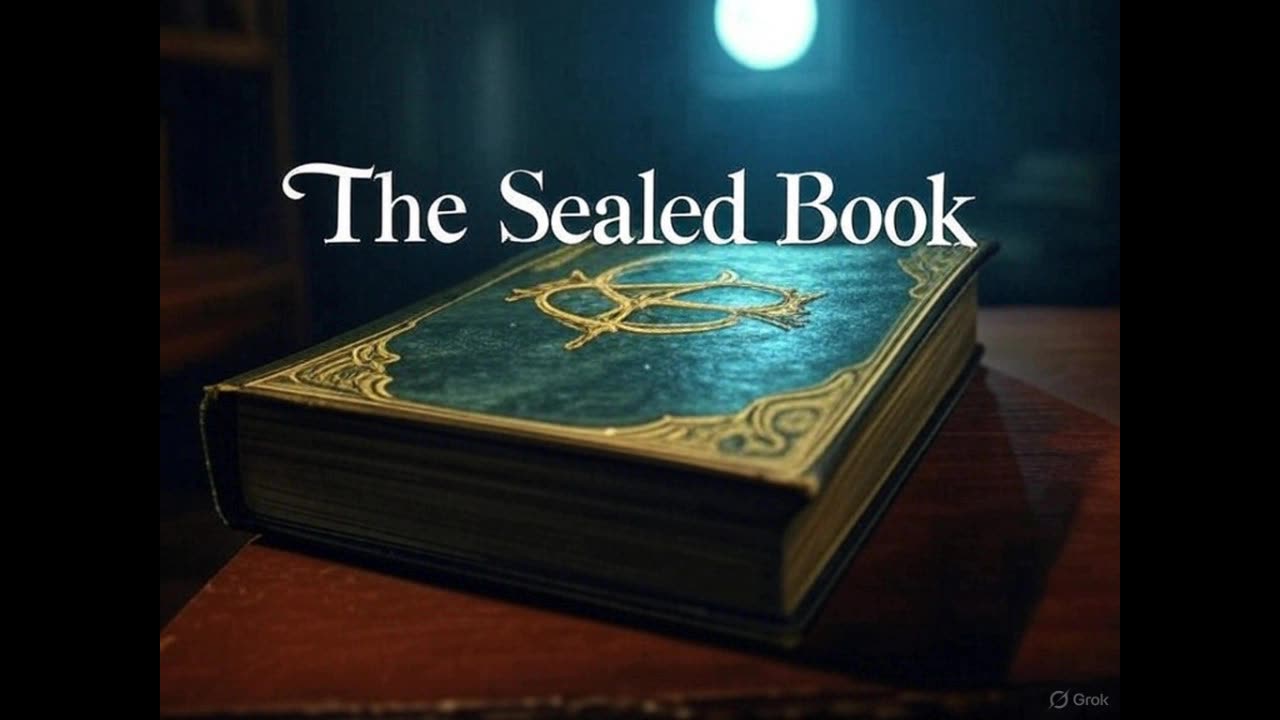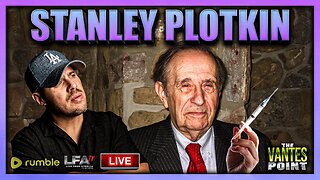Premium Only Content

The Sealed Book: Death Spins a Web (April 1, 1945)
Setting: A contemporary (1945) American setting, likely an urban apartment, a secluded mansion, or a foggy coastal town, with scenes evoking a web-like trap—possibly a shadowy parlor, a basement, or a metaphorical maze of deceit. The episode uses sound effects like creaking floors, rustling silk, eerie whispers, and organ music to create a suspenseful, sinister atmosphere.
Plot:
Introduction: The episode opens with the sound of a great gong, signaling the start of the tale. Host Philip Clarke, as the “Keeper of the Book,” delivers a dramatic narration, describing how the “mysteriously silent keeper” opens the secret vault containing the great sealed book, which holds “all the secrets and mysteries of mankind through the ages.” He introduces “Death Spins a Web,” a “tale of treachery, of a deadly trap woven with cunning, and the doom that awaits its prey.”
The Premise: The story likely centers on a scheming antagonist—possibly a femme fatale, a cunning manipulator, or a vengeful mastermind—who weaves a metaphorical “web” of deceit to ensnare victims, leading to murder or supernatural retribution. The “web” could involve a complex plot of blackmail, seduction, or betrayal, with the antagonist luring victims into a trap for wealth, revenge, or power. The narrative might begin with a victim, unaware of the danger, encountering the antagonist in a seemingly innocent setting, with hints of menace conveyed through sly dialogue or eerie sound effects like rustling fabric or a ticking clock.
Escalating Horror: As the antagonist’s plan unfolds, the web tightens. Victims—perhaps a naive heir, a curious detective, or a betrayed lover—realize they’re trapped, with scenes of mounting dread as they uncover lies or face mortal danger. A supernatural element may emerge, such as a ghostly presence, a cursed object (e.g., a spider-shaped jewel), or a spectral “web” that physically or metaphorically ensnares souls. Sound effects like whispers, footsteps, or a sudden scream amplify the tension, with the setting becoming a claustrophobic prison of deceit. The antagonist’s cold calculation contrasts with the victims’ growing panic, driving the horror.
Climax and Resolution: The climax features a confrontation, likely in a dramatic setting like a darkened room or foggy alley, where the protagonist or a survivor attempts to unravel the web. The twist, typical of Arthur and Kogan’s scripts, could reveal that the antagonist is undone by their own scheme—perhaps the supernatural web turns against them, or a victim outwits them at the last moment. Alternatively, the web’s true nature might be a demonic force, claiming all involved. Philip Clarke closes with a moral warning about the perils of deceit, urging listeners to tune in next week when “the sound of the great gong heralds another strange and exciting tale from… the sealed book.”
Themes: The destructive power of manipulation, the inevitability of justice, and the horror of being ensnared by one’s own greed or treachery. The episode blends psychological suspense with supernatural horror, reflecting 1940s fascination with noir-style deceit and gothic terror.
Cast and Roles:
Antagonist (Manipulator): Played by an unnamed actor, likely a Mutual Network regular, portraying a cunning, charismatic figure—possibly a femme fatale or scheming mastermind—with a seductive or chilling tone, weaving the deadly web.
Protagonist/Victim: Played by an unnamed actor, depicting a sympathetic or determined character—perhaps a detective, heir, or lover—caught in the trap, with a voice shifting from curiosity to desperation.
Supporting Characters: An ensemble of unnamed actors, possibly including:
Accomplice: A nervous or greedy ally to the antagonist, voiced with anxiety or menace, aiding the scheme.
Minor Roles: Additional victims, a suspicious friend, or a ghostly voice, voiced by the ensemble to add depth or supernatural dread.
Host/Narrator (Keeper of the Book): Philip Clarke, delivering the opening and closing narrations with a melodramatic, foreboding tone, framing the story’s horror and moral lesson.
Note on Cast: The Sealed Book rarely credited actors beyond Clarke, relying on New York-based radio talent shared with The Mysterious Traveler. Performances were exaggerated, with “hammy” acting suited to the series’ pulpy, sensational style.
Production Details:
Music: Eerie organ music, likely composed by Mutual’s in-house musicians, opens and closes the episode, with suspenseful stings accentuating dramatic moments. The score enhances the noir and gothic horror mood, similar to Inner Sanctum Mysteries.
Writers: Robert Arthur Jr. and David Kogan, known for The Mysterious Traveler, crafting a tale blending crime, suspense, and supernatural twists, likely recycled from their earlier scripts.
Producer/Director: Jock MacGregor, ensuring the episode’s tight 30-minute pacing and immersive sound design, a hallmark of Mutual’s mystery series.
Sound Effects: Critical to the episode, including creaking floors, rustling silk, eerie whispers, footsteps, screams, or ticking clocks, creating a vivid, sinister atmosphere. The “web” might be suggested by subtle, thread-like sounds or ghostly rustling.
Sponsor: None, as The Sealed Book was a sustaining program, airing late Sundays on Mutual stations, supported by the network’s commitment to dramatic programming.
World and National Events Around April 1, 1945:
To provide context for the broadcast, here are key world and national events occurring in late March and early April 1945, reflecting the intense wartime climate that shaped listeners’ perspectives:
World Events:
World War II – European Theater: The Allies were advancing rapidly into Nazi Germany. By late March, Operation Plunder (March 23–27) saw British, Canadian, and U.S. forces cross the Rhine, and by April 1, the Ruhr Pocket was being encircled, trapping 300,000 German troops. Radio news reported Germany’s collapse as imminent, with Berlin within reach.
Pacific Theater: The Battle of Okinawa began on April 1, 1945, with U.S. forces invading the island, a critical step toward Japan’s defeat. Following the costly Iwo Jima victory (February 19–March 26), Okinawa’s scale (over 180,000 U.S. troops) dominated radio and newspaper coverage, underscoring the Pacific war’s brutality.
Holocaust Revelations: Allied liberations of Nazi concentration camps accelerated, with Ohrdruf (a Buchenwald subcamp) liberated on April 4, exposing horrific conditions. By late March, early reports of atrocities reached the U.S., with radio broadcasts amplifying calls to end the war, though the Holocaust’s full scope was still emerging.
Post-War Planning: The Yalta Conference (February 4–11) agreements shaped news, with the upcoming United Nations Conference in San Francisco (April 25) planned to establish a post-war order. Radio emphasized Roosevelt’s peace vision, amid growing U.S.-Soviet tensions over Eastern Europe.
National Events:
War Mobilization: The U.S. war effort was at its peak, with rationing of gas, food, and clothing ongoing. War bond drives, heavily promoted on radio, urged civilian support, while factories produced munitions at record rates, a focus of national pride.
Japanese American Incarceration: By April 1945, some Japanese Americans were returning home after the December 1944 Supreme Court ruling against internment, but many remained in camps like Tule Lake. Radio and press debates reflected shifting views on the policy as the war neared its end.
Entertainment and Morale: Hollywood and radio boosted morale. Films like The Picture of Dorian Gray (March 1) and A Tree Grows in Brooklyn (February 1945) were popular, while radio shows like The Jack Benny Program and Amos ‘n’ Andy mixed humor with patriotic appeals. The Sealed Book’s horror offered escapism from war’s stress.
Sports and Culture: The 1945 baseball season was starting, with teams like the Chicago Cubs preparing despite wartime player shortages. Frank Sinatra’s hits, like “Saturday Night (Is the Loneliest Night of the Week),” dominated airwaves, reflecting the era’s vibrant music scene.
Cultural Context: Aired in the final months of World War II, “Death Spins a Web” resonated with American listeners by tapping into fears of betrayal and hidden dangers, mirroring anxieties about espionage and Axis deception as the war neared its climax. The episode’s noir-style web of treachery echoed wartime narratives of outwitting enemies, offering catharsis as the U.S. anticipated victory in Europe and braced for Okinawa’s toll. Its gothic horror, rooted in pulp traditions, aligned with 1940s fascination with suspense, seen in noir films like Laura (1944). The late Sunday slot, typically for lighter fare, made The Sealed Book’s dark tales a bold draw for thrill-seekers nationwide, with its Mysterious Traveler connection ensuring appeal for horror radio fans.
-
 LIVE
LIVE
Rallied
1 hour ago $0.02 earnedSolo Challenges All Day
120 watching -
 1:44:19
1:44:19
Redacted News
2 hours agoHIGH ALERT! BRICS CALLS EMERGENCY MEETING IN BRAZIL, TRUMP THREATENS TO DESTROY RUSSIAN ECONOMY
94.4K53 -

Stephen Gardner
1 hour ago🔥FINALLY! Trumps ORDER TODAY has Democrats PANICKED!
9.36K5 -
 30:38
30:38
Kimberly Guilfoyle
3 hours agoBreaking News Coverage, Live with Former DEA Administrator Derek Maltz & Tony Kinnett | Ep252
13K4 -
 48:17
48:17
Mark Kaye
6 hours ago🔴 What Trump Said About Prayer in Schools SHOCKED Everyone!!
32.3K14 -
 LIVE
LIVE
LFA TV
19 hours agoLFA TV ALL DAY STREAM - MONDAY 9/8/25
1,247 watching -
 1:10:49
1:10:49
vivafrei
3 hours agoCNN Finallly Reports on Stabbing! GoFundMe Scam or Psy-Op? Trump E.J. Carroll Ruling & MORE
80K74 -
 2:19:15
2:19:15
Tucker Carlson
5 hours agoBill Gates, Truth About Vaccines, & Big Pharma’s Plot to Destroy Doctors Who Question ”The Science”
109K118 -
 LIVE
LIVE
Film Threat
18 hours agoVERSUS: CONJURING BOX OFFICE HORROR | Film Threat Versus
107 watching -
 8:32
8:32
Millionaire Mentor
6 hours agoAdam Schiff LOSES IT After Trump’s AG EPICALLY Fires Back
12.7K12